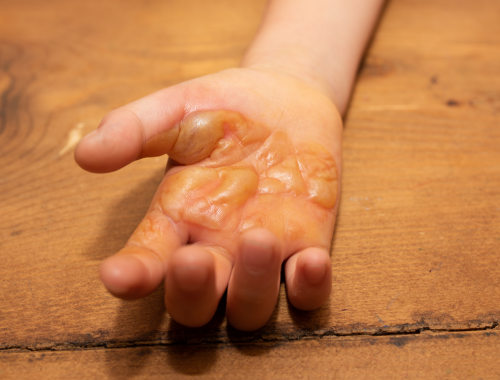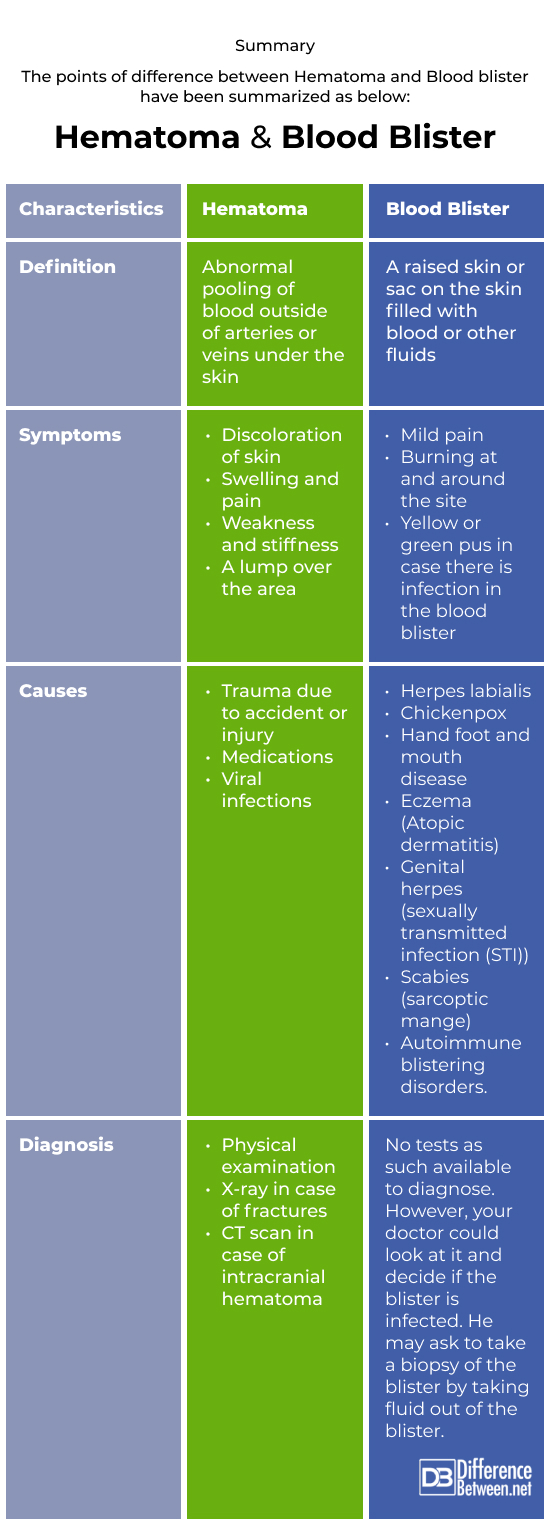Difference Between Hematoma and Blood Blister

Difference between Hematoma and Blood blister
A blood blister is a tiny bubble usually seen in the layers of the skin (epidermis) and the bubble contains blood and is caused by infection, disease, insect bites, injury, repeated rubbing, freezing, burning, friction and pressure, and allergens and irritation causing allergens. An infected blister could cause cellulitis or life-threatening blood infection called sepsis. Hematoma is a swelling and clotting of blood usually under the nails or skin, or in a tissue or body space. This clotting happens because of damage to the broken blood vessels (capillaries, veins, or arteries) due to injury or surgery.

Similarity
Both hematoma and blood blister show symptoms like pain, discomfort, and discoloration.
Hematoma
A hematoma is described as pooling of blood outside your damaged arteries and veins (blood vessels) usually hit by an injury. Blood starts clotting outside blood vessels after an injury in a muscle or a body tissues and can develop a lump or hard mass beneath the surface of your skin.
Blood blister
A bump, small pockets, or a bubble on the skin that’s filled with blood. It usually forms because of bruising, pinching or putting the skin in extreme pressure.
Difference between Hematoma and Blood blister
Definition
Hematoma
Hematoma is basically a bad bruise. It occurs when there is pooling or clotting of blood outside the blood vessels (arteries, capillaries, or veins) under the skin.
Blood blister
A blood blister is a pocket like bubble filled with blood or other fluid. It looks like a friction blister. It forms when the dermal tissues beneath the skin layer and the blood vessels are damaged because of pinching or rubbing or burning the skin.
Causes
Hematoma
- Trauma due to accidental injury, fall, fracture, head injury
- Certain kind of medications
- Viral infections such as hepatitis C, mumps, rubella
Blood blister
- Cold sores (herpes labialis)
- Chickenpox
- Hand foot and mouth disease
- Diabetes (in rare cases)
- Eczema (Atopic dermatitis)
- Genital herpes (sexually transmitted infection (STI))
- Scabies (sarcoptic mange)
- School sores (impetigo) (a common skin infection caused by bacteria)
- Autoimmune blistering disorders.
Symptoms
Hematoma
- Tenderness in the affected area
- Pain and discomfort
- Discoloration or redness
- Inflammation
- Warmth
- Swelling
Blood blister
A blood blister could appear on your hands, mouth, feet, toes, heels, and joints. It is usually red, or purple or even turns blackish in color. Symptoms include pain, discomfort, itching and redness in the area of the blister. An infected blister could be filled with green or yellowish pus and could be hot to touch as well.
Summary
The points of difference between Hematoma and Blood blister have been summarized as below:

FAQ:
Is hematoma the same as blood blister?
Blood blisters are usually examples of hematoma. Hematoma is a result of blood accumulating in the exterior of weakened arteries and veins.
What does the start of a hematoma look like?
Hematoma could look like a bad bruise where the arteries or veins are damaged and blood starts collecting or clotting outside the blood vessels under the skin.
How do you know if you have a hematoma?
Your doctor can confirm if you have a hematoma by looking at the disfiguring bruises, swelling and tenderness and redness in the affected area.
What does hematoma blood look like?
It looks like a purplish, dark red or blue spot or lump. The pooling blood makes the skin look spongy and lumpy.
Does a hematoma need to be drained?
Surgical drainage of hematoma is required in certain cases. For example, if hematoma occurs in brain or if there is nasal septal hematoma.
Should I pop a hematoma?
You should never try to pop or drain a hematoma by yourself at home. It could be dangerous as it may cause infection. Only surgical drainage by a medical professional is recommended.
What happens if a hematoma is left untreated?
A small hematoma usually disappears without treatment in sometime. However, if a clot or blood bubble from a hematoma finds its way again into the bloodstream and expands over a course of few days, it can block an artery, breaking off blood flow to tissues and other organs of the body. In the absence of immediate treatment, a permanent damage to the tissues could happen.
When is it too late to drain a hematoma?
It is advisable to head to your healthcare provider within 48 hours of your injury.
The blood begins to clot and there is extreme swelling after this time period. And then draining a hematoma becomes too difficult. It is too late to drain a hematoma after 48 hours of injury.
Will a hematoma eventually go away?
It depends on the cause of hematoma. Most of the hematomas usually dissolve on their own within 1-4 weeks. Some require surgical drainage depending upon the symptoms and location of hematoma in the body.
- Difference Between Global Warming and Greenhouse Effect - May 18, 2024
- Difference Between Vaccination and Immunization - March 3, 2024
- Difference Between Selective Mutism and Autism - February 25, 2024
Search DifferenceBetween.net :
Leave a Response
References :
[0]Ducruet, A. F., Grobelny, B. T., Zacharia, B. E., Hickman, Z. L., DeRosa, P. L., Anderson, K., ... & Connolly, E. S. (2012). The surgical management of chronic subdural hematoma. Neurosurgical review, 35, 155-169.
[1]Horie, N., Morikawa, M., Fukuda, S., Hayashi, K., Suyama, K., & Nagata, I. (2011). Detection of blood blister–like aneurysm and intramural hematoma with high-resolution magnetic resonance imaging: Case report. Journal of neurosurgery, 115(6), 1206-1209.
[2]Meling, T. R., Sorteberg, A., Bakke, S. J., Slettebø, H., Hernesniemi, J., & Sorteberg, W. (2008). Blood blister–like aneurysms of the internal carotid artery trunk causing subarachnoid hemorrhage: treatment and outcome. Journal of neurosurgery, 108(4), 662-671.
[3]Zhu, D., Yan, Y., Zhao, P., Duan, G., Zhao, R., Liu, J., & Huang, Q. (2018). Safety and efficacy of flow diverter treatment for blood blister–like aneurysm: a systematic review and meta-analysis. World neurosurgery, 118, e79-e86.
